This Just the Tip comes from Eric Silva, Silva Mechanical, West Broomfield, Mich. What three things does he suggest before starting every job? Oh, and a BONUS tip? https://youtu.be/0sBYRtFdjrA Read more
HVAC

This Just the Tip comes from Eric Silva, Silva Mechanical, West Broomfield, Mich. What three things does he suggest before starting every job? Oh, and a BONUS tip?
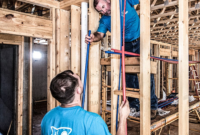
Organizations will work together to emphasize career opportunities in the trades Reliance Worldwide Corporation (RWC), a leading manufacturer of premium branded push-to-connect plumbing products, valves, secondary pipe supports, firestopping solutions and fluid control technologies, is partnering with Home Builders Institute (HBI), a national leader in career training for the building and construction industry, as the exclusive Trade Read more
Organizations will work together to emphasize career opportunities in the trades
Reliance Worldwide Corporation (RWC), a leading manufacturer of premium branded push-to-connect plumbing products, valves, secondary pipe supports, firestopping solutions and fluid control technologies, is partnering with Home Builders Institute (HBI), a national leader in career training for the building and construction industry, as the exclusive Trade Sponsor for its 22 plumbing programs across the U.S., primarily serving Job Corps students and justice-involved individuals.
These HBI programs provide students with the skills, experience and placement services they need to have a successful career while helping the trade address labor shortages.
“We are thrilled to engage with HBI and believe this is the beginning of an important, long-lasting partnership,” said Chris Carrier, Marketing Director, Americas at RWC. “HBI’s ability to connect, train and place potential new talent into the trade makes them an ideal partner. Not only do we see this as an opportunity to help our trade, but also an opportunity to help the local communities that these programs are in.”
This partnership was a natural opportunity for RWC to double down on its commitment to promote and further the plumbing trade after its Careers in Construction Month efforts, through its SharkBite® and HoldRite® brands, in October.
“Our diverse product portfolio enables us to produce solutions that are designed to help plumbing contractors work more efficiently in the field,” Carrier continued. “In our conversations with them, we’ve recognized the need to help the trade address its labor challenge.”
HBI’s programs help approximately 10,000 students each year receive real life, hands-on training and find meaningful careers in the trades. HBI also provides them with job placement and transition assistance, and qualified graduates are able to enter advanced training programs to expand their education and experience.
“Home Builders Institute is proud to welcome our new partner, Reliance Worldwide Corporation,” said HBI President and CEO Ed Brady. “Together, we are training the next generation of skilled labor for the building industry. As HBI’s exclusive Trade Sponsor of our plumbing programs, RWC will provide its excellent products to help train our students in 22 locations nationwide. In the process, they will develop customers for life as our graduates enter the industry. I look forward to working with RWC and to seeing how the many resources they bring to the table will help enhance our training programs and ensure the future success of our students.”
To further discuss this partnership during IBSx – the 2021 International Builders Show – please visit RWC or HBI’s exhibits. Learn more about RWC and its family of brands.
Apple Valley, Minn. — Uponor North America (Uponor), a pioneer and leading provider of PEX (crosslinked polyethylene) piping products, launched its new Complete Polymer Solution for commercial-piping applications in the U.S. The innovative platform for this important announcement is a special, 90-minute, virtual event for customers, specifiers, installers, and other buying influencers in the commercial Read more
Apple Valley, Minn. — Uponor North America (Uponor), a pioneer and leading provider of PEX (crosslinked polyethylene) piping products, launched its new Complete Polymer Solution for commercial-piping applications in the U.S. The innovative platform for this important announcement is a special, 90-minute, virtual event for customers, specifiers, installers, and other buying influencers in the commercial plumbing and mechanical field.
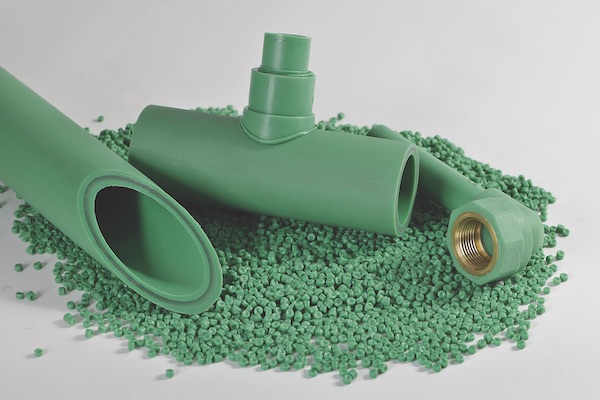
The online unveiling included the official launch of two important initiatives: Uponor’s new PP-RCT mechanical piping system for commercial HVAC projects; and the new Uponor Construction Services, offering enhanced, professional estimation, design, and building information modeling (BIM) services to support the design and installation of plumbing and mechanical piping systems.
“Our new PP-RCT and Construction Services offerings, combined with our traditional PEX piping solutions, deliver a complete polymer solution for a wide range of commercial plumbing and mechanical projects,” says Bill Gray, president of Uponor North America. “From half-inch diameter PEX to 12-inch diameter PP-RCT, our piping solutions meet the performance, durability, and safety needs of the entire commercial structure. In addition to these industry-leading piping products, Uponor Construction Services can provide the systems design and engineering expertise to ensure a project is fully supported from kickoff to post-construction.”
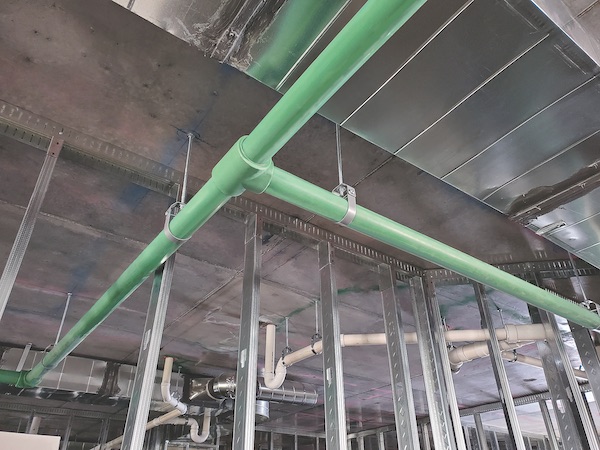
Empire Pass Condos, Park City, Utah, AquaPEX and PP-RCT install 2019, Thermal Engineering, PNA
PP-RCT piping system: Uponor PP-RCT (PolyPropylene, Random copolymer with modified Crystallinity and Temperature resistance) has higher temperature and pressure ratings than PP-R pipe, as well as lower levels of expansion and contraction.
Proven reliable for commercial hydronic heating, chilled-water cooling, and distribution piping for radiant heating and cooling applications — including snow melt, turf conditioning, and permafrost prevention — PP-RCT is 80 percent lighter than steel pipe. That makes it not only easier, but also safer, to install than metallic pipe systems. It also offers higher resistance to corrosion, rust, and scale buildup and quieter operation than metallic piping materials.
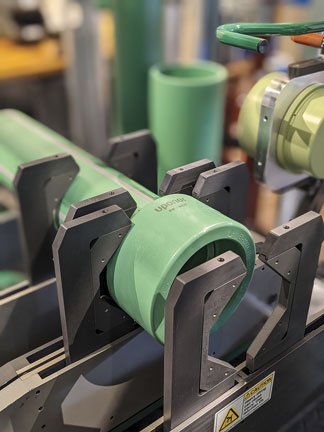 In addition, contractors will be able to bid projects with more certainty and confidence, as polymer piping offers stable pricing that doesn’t fluctuate with market changes unlike alternative piping materials.
In addition, contractors will be able to bid projects with more certainty and confidence, as polymer piping offers stable pricing that doesn’t fluctuate with market changes unlike alternative piping materials.
Uponor initially announced its entry into the North American PP-RCT market in September 2019 through a partnership agreement with Pestan North America. As a result, Uponor is now marketing approximately 270 pipe and fitting products in the U.S. in sizes up to 12 inches in diameter and with plans to expand up to 24 inches. All Uponor PP-RCT pipe and fittings come protected by a 10-year warranty.
“With this new piping system, we are also offering comprehensive training and expert technical support — both online and through our nationwide network of in-person sales professionals — to help contractors learn our PP-RCT system,” says Gray. “This includes making pipe connections with special heat-fusion equipment, via our partnership with McElroy Manufacturing, the leading manufacturer of fusion equipment.”
Gray went on to say that whether their customers select virtual or hands-on training, Uponor’s professional guidance helps installers master best practices for both PP-RCT and PEX, helping to keep their projects on schedule and within budget.
Construction Services: Continuing its 27-year history of offering PEX piping system design for both residential and commercial radiant heating, cooling, and plumbing, residential fire safety, and commercial hydronic piping, Uponor has expanded this offering to become Uponor Construction Services, featuring regionally based designers, as well as a team of BIM experts.
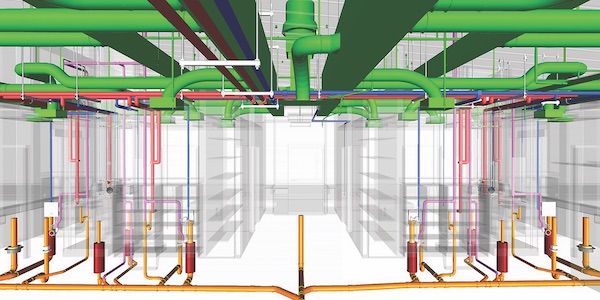 Using the latest design and estimating tools, the Uponor team of skilled and experienced designers and project managers offers a deep menu of design and construction services at no charge, including:
Using the latest design and estimating tools, the Uponor team of skilled and experienced designers and project managers offers a deep menu of design and construction services at no charge, including:
- Square-foot budget estimations
- Material take-offs
- Piping material cost comparisons
- Design development
- Radiant heating and cooling loop layouts
- Pipe sizing and load recommendations
In addition, Uponor Construction Services provides fee-based, system design services (plansets in PDF, Revit®, and fabrication models), quoted to meet the particular needs of individual projects, at prices below standard industry system-design rates.
Other fee-based services from the BIM Services team include:
- Record modeling
- Estimating
- As-built modeling
- On-site support
- Project controls
- Modular construction
- Kitting and prefabrication
- BIM content
All of these services integrate directly into the user’s software platform and workflows, providing an integrated partnership with an end goal to deliver a well-designed project that is properly coordinated and fully supported.
“Evolving our Construction Services offering was in response to customer feedback and their growing expectations related to project efficiency, accuracy, quality, and consistency to better meet schedules and budgets,” says Gray. “We saw an opportunity to become a more involved partner from the very start of a project through construction onto completion and beyond. With this project-spanning partnership, we are confident we can help improve customers’ productivity and profitability.”
Since the evolution of Uponor Construction Services and the PP-RCT partnership announcement with Pestan in 2019, Uponor has provided PP-RCT piping systems and design expertise for several commercial projects in the U.S. The largest and most notable of these is a recently completed hybrid snow-melt system, involving both 1,900 feet of Uponor PP-RCT and 36,000 feet of Wirsbo hePEX™ pipe, for a 305-foot pedestrian bridge on the Utah Valley University campus in Orem, the largest public university in the state.

When I asked Conrado Ensenat Jr.—aka @conradtheplumber—if he ever considered himself a role model to young people thinking of entering the trades, he unequivocally answered, “No, absolutely not.” Yet his answer wasn’t completely without, perhaps, an internal epiphany. You see, according to Conrad, the way he does things may not be the way others do Read more
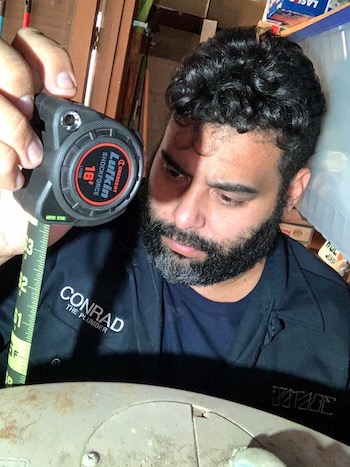 When I asked Conrado Ensenat Jr.—aka @conradtheplumber—if he ever considered himself a role model to young people thinking of entering the trades, he unequivocally answered, “No, absolutely not.” Yet his answer wasn’t completely without, perhaps, an internal epiphany. You see, according to Conrad, the way he does things may not be the way others do things. And that’s okay. But in reality, unbeknownst to Conrad, he may just be moving into that role model role as we speak. “What I am is a plumber that has no problem taking the time to answer any kind of question an apprentice or a student in school may have about our trade,” says Ensenat. “I believe we are more approachable today more than ever; communication is so much easier with social media. So, for me, a role model I am not. But a plumber with the love for the trade and wanting to see young people succeed if they want to pursue a career, then I most certainly am.”
When I asked Conrado Ensenat Jr.—aka @conradtheplumber—if he ever considered himself a role model to young people thinking of entering the trades, he unequivocally answered, “No, absolutely not.” Yet his answer wasn’t completely without, perhaps, an internal epiphany. You see, according to Conrad, the way he does things may not be the way others do things. And that’s okay. But in reality, unbeknownst to Conrad, he may just be moving into that role model role as we speak. “What I am is a plumber that has no problem taking the time to answer any kind of question an apprentice or a student in school may have about our trade,” says Ensenat. “I believe we are more approachable today more than ever; communication is so much easier with social media. So, for me, a role model I am not. But a plumber with the love for the trade and wanting to see young people succeed if they want to pursue a career, then I most certainly am.”
His Calling
Early on, Conrad was working for a restaurant and just starting at a local community college, yet he wanted something more. Working with his hands always appealed to Conrad so he quit the restaurant and started working as a carpenter’s helper. “It was okay, but saw what the plumbers were doing with the soldering and PVC, and I was intrigued,” Conrad says.
Conrad was hired as a helper cutting and removing cast iron pipe in a building in downtown Miami and loved it right away. “Sure, I was dirty and smelled bad but learning about the pipe and how it works was just really cool. Seventeen years later and I’ve never looked back; plumbing was my calling.”
Conrad’s journey into the plumbing trades technically began full time in 2002 where he started on “snake patrol,” as he was given a van full of all types of machines for drain cleaning—RIDGID, Electric Eel, General Pipe Cleaner, etc. “I learned quickly how to use these machines—I got slapped in the face by a cable, had my shoelaces ripped off after the cable got tangled on them and got splashed with sewer and grease—and all of this happened within my first two days.”

After one year, Conrad begged his boss for an upgrade and was moved over to camera inspections. Here, Conrad learned the insurance side of things for residential and commercial applications—how it all works and the importance of video and the location of problems. At this time, Conrad also was installing temporary sinks and water heaters, and doing leak detection as well. After about six months, Conrad went into new construction, completing multiple high-end buildings and renovations in multiple hotels. After about a year, Conrad took over as lead plumber on two high-end homes in Sunset Island and Hibiscus Island, Miami Beach. “One project took seven years to complete while the other took four, and that meant a lot of money and a lot of change orders,” says Ensenat.
At this time, Conrad bounced from lead plumber to supervisor—in charge of about 17 plumbers and 10 helpers—ordering material, pricing out jobs, and meeting with contractors and owners. “I didn’t carry a tool or do any labor for about four years; it was mostly delegating and office work. It was a bit boring at times and the days were long and sometimes stressful, but you go on,” says Ensenat.

Conrad with Omar Harris (left).
After the company closed its doors and went into new ownership, Conrad decided it was time to go on his own. He opened a company with a partner and ran it for four years.
“I tip my hat to all the business owners, but there’s another side to that coin. The long days and nights—being held accountable for what your plumbers and helpers do, calling contractors for payment, supply houses, bills, gas, insurance, marketing, etc. It was great for a while but I was working a lot, and when you’re on your own, you want every call and every job as the stress of business falls on you. You need to bring in the money for your plumbers and office staff. They depend on you.”
But in the end, family was most important to Conrad. There was a time Conrad was working 6-7 day a week, 15-20 hours per day. “So, I closed shop and went and worked for a commission company, which was not the best decision, but I did see another side of plumbing I hadn’t seen, which I am not too fond of. But I did meet my best friend Omar Harris there, and met some great plumbers like Hiram Martinez and Joey Neal. These are great guys with vast knowledge of the trade.”
After leaving that company, Conrad joined the Broward County Parks and Recreation Division, where he has been for the past three years. “I couldn’t have made a better choice for me and my family.”

Looking back to when he started, Conrad says he didn’t know what he was doing but always enjoyed learning. And, as he was putting systems together and turning on/off the water, gas, or testing a drainage system, there was a sense of accomplishment. “We all have that story where we figured out a leak when five other plumbing companies could not. Where we worked all night, were dead tired, and when they asked, you said ‘you had to be there.’ The journey is different but the end result is the same,” says Ensenat. “The customer is coming to you with a problem and needs you to solve it. Putting that trust in you is a great feeling and honor; they could’ve picked anyone but they picked you.”
Learning from the Past
Conrad owes a lot of what he knows in the trades to William Gonzalez. “That man taught me a lot and would become my future father-in-law. He was an old-school plumber since the ’70s and he did not take it easy on me—probably because I was dating his daughter, lol. But he showed the business side of plumbing. He pushed me in new directions and always challenged me, whether it was reading plans delegating or a simple stoppage. His passion became my passion and my drive to learn all new methods of plumbing. I will be forever grateful to him, leaving me with the knowledge to make it in this trade; he may be gone, but never forgotten.”
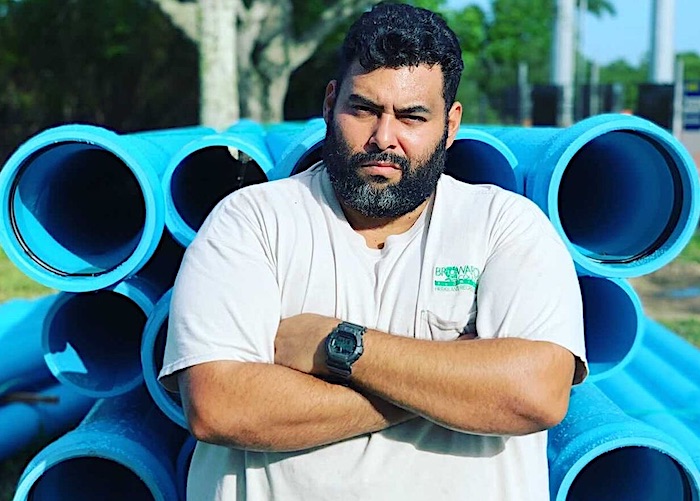
Conrad’s brother-in-law, Guillermo Gonzalez, also taught him a lot about gas, and working with tankless water heaters. “Like his dad, he is a great person, and I was very lucky to be welcomed into the family—not only have they shown me love but they showed me a trade and a skill that will never be taken away. I have taken what they taught me and I have taught others as well,” says Ensenat.
Social Media All-In
According to Conrad, social media has been a great tool from talking to people all over the world to seeing the different methods of plumbing that are used—from the equipment to the way others approach the work. “We are a community here to help each other answer questions: we are at a time with social media where you can ask a question to a professional and get a real answer from the people that do it and live the trade,” says Ensenat.
Speaking of helping others, Conrad and his best friend Omar Harris (@omartheplumber) are in the initial stages of their PipeTalk “Instacasts”on Instagram. “We want a show where we can talk about anything in the trade, not a show about showcasing tools or doing giveaways. Real talk about experiences in the trade. How we can truly help apprentices understand what they are getting into,” says Ensenat.
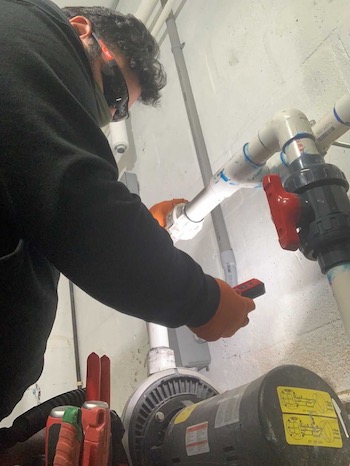 In the end, for Conrad, it’s important to show new apprentices that the plumbing trade is not just about labor-intensive work; there is a future beyond just being a plumber. For instance, you can become lead plumber or foreman, says Conrad, or you can get your license and become an inspector or a plans processor. “There are so many great paying jobs with opportunities revolving around plumbing than just installing pipe, tubs and toilets all day. And this goes for any man or woman and every color and race—you have the opportunity to go far as you want.”
In the end, for Conrad, it’s important to show new apprentices that the plumbing trade is not just about labor-intensive work; there is a future beyond just being a plumber. For instance, you can become lead plumber or foreman, says Conrad, or you can get your license and become an inspector or a plans processor. “There are so many great paying jobs with opportunities revolving around plumbing than just installing pipe, tubs and toilets all day. And this goes for any man or woman and every color and race—you have the opportunity to go far as you want.”
And with that hard work comes a little down time. Before the pandemic, Conrad would take multiple vacations a year to spend time with his family. “When I’m off work, I’m off. The two days a week I’m off, it’s all about either what I’m doing or spending time with the kids or the wife,” says Ensenat.
During football season, it’s all about the Miami Dolphins—Conrad would enjoy tailgating and going to games, including road games. Oh, and the last time Conrad said today is a great day? “I opened a cleanout at the front of a house holding water. Stuck the cable in 3 feet and it cleared without turning the machine on. Winner, winner, chicken dinner.”
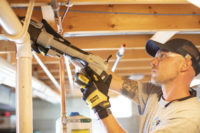
Pressgun 6 and Pressgun 6 Picco offer an affordable entry to pressing technology Broomfield, Colo. — Viega LLC, the company which introduced pressing to North America, now has its own branded pressing tools for use with its fittings. The Viega Pressgun 6 and Pressgun 6 Picco are now available in distributors and through Viega. The Read more
Pressgun 6 and Pressgun 6 Picco offer an affordable entry to pressing technology
Broomfield, Colo. — Viega LLC, the company which introduced pressing to North America, now has its own branded pressing tools for use with its fittings.
The Viega Pressgun 6 and Pressgun 6 Picco are now available in distributors and through Viega. The tools, which are the first in North America to carry the Viega name, cost less than similar press tools from other manufacturers and are an affordable way for contractors to adopt pressing.
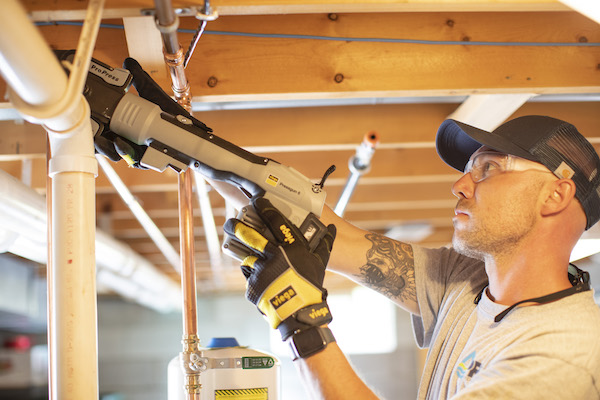
“We know the cost of tools has been a barrier for some contractors who want to adopt pressing,” said Dominic Küng, Senior Manager, Product Portfolio. “The lower price of the Pressgun 6 and Pressgun 6 Picco will make it easier for those customers to buy a tool and begin realizing the enormous benefits of pressing.”
Tools aren’t a new offering for Viega. It has sold branded tools in Europe for years in collaboration with RIDGID, whichmanufactures the Pressgun 6 and Pressgun 6 Picco for Viega.
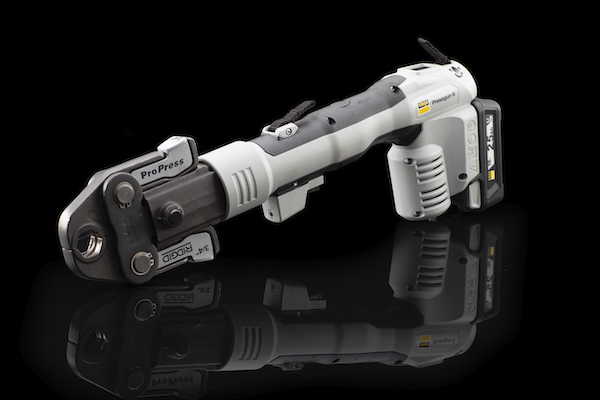
The Pressgun 6 is a no-frills, cost-efficient workhorse that can press up to 4″ ProPress copper and stainless and 2″ MegaPress with the V2 actuator and rings, as well as 2″ PureFlow PEX. Its features include:
- Eight-second press cycle
- LED display indicating number of presses left on a charge
- Steel cylinder head and jaw intake
- 270° rotating cylinder head
- Forward and backward compatibility with RIDGID batteriesThe less expensive and less powerful Pressgun 6 Picco can press up to 11⁄4″ ProPress with the C1 actuator and rings, 11⁄2″ PureFlow and 3⁄4″ MegaPress.
Neither tool can be used with the MegaPress XL PressBooster or MegaPress Z3 Actuator.
Both tools come with an 18-volt lithium-ion battery and charger. The 2.5/5.0 Ah battery offers 25% more presses per charge than the previous battery. It includes a battery life indicator. The charger comes with a standard 100-240V charging cord and a 12V DC charging cord so it can be charged off a vehicle lighter. The battery also features forward and backward compatibility with RIDGID batteries, chargers and tools.
“We’re excited to make it possible for additional contractors to become more efficient and productive through pressing,”Küng said. “They’ll find that the Pressgun 6 and Pressgun 6 Picco will revolutionize their businesses and quickly pay for themselves.”
To learn more about the tool, visit here.
